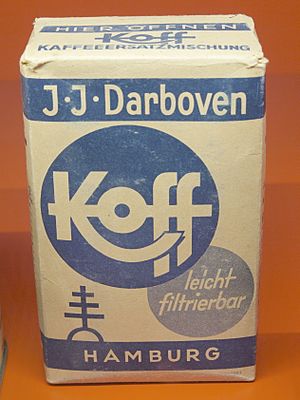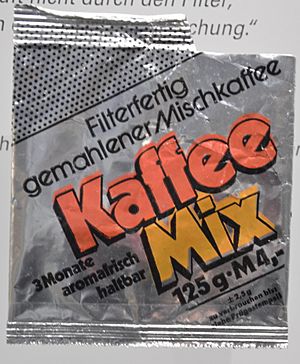Coffee substitute facts for kids
Coffee substitutes are drinks that look and taste a bit like coffee but aren't actually coffee. They usually don't have caffeine, which is the stuff in coffee that gives you energy. People use them for different reasons, like if they can't drink caffeine, if coffee is too expensive, or if it's hard to find. Drinks made from roasted grains are common coffee substitutes.
During World War II, people used things like acorns, roasted chicory, and grains to make coffee. This happened because real coffee was hard to get. Also, during the American Civil War, coffee was very scarce in the southern parts of the U.S..
Sometimes, coffee substitutes are used when making food for children. They are also used by people who want to avoid caffeine. Some people believe these drinks are healthier than regular coffee.
In some places, like Korea, people have traditions of drinking hot beverages made from roasted grains. Examples include boricha (barley tea), oksusu cha (corn tea), and hyeonmi cha (brown rice tea). These aren't really coffee substitutes, but they are popular hot drinks, sometimes sweetened, just like coffee or tea.
Contents
What Are Coffee Substitutes Made Of?
Coffee substitutes, especially grain coffees, are made by roasting or boiling different natural things.
Here are some ingredients that have been used:
- almonds
- acorns
- asparagus
- barley and malt
- beech nuts
- beetroot
- carrots
- chicory root
- corn
- cotton seeds
- dandelion root
- figs
- boiled-down molasses
- okra seeds
- peas
- persimmon seeds
- potato peels
- rye
- sassafras nuts
- sweet potatoes
Chicory has been sold widely since about 1970. It became a very common product. It was also used a lot during the American Civil War by both sides.
Postum is an instant drink that was used instead of coffee. It was most popular during World War II.
Examples of Coffee Substitutes
- Barleycup is a similar product sold in the UK.
- Camp Coffee is a mix of chicory and coffee from the UK. It has been sold since 1876.
- Nestlé Caro is made from roasted barley, malted barley, chicory, and rye. It is used as a coffee substitute. Pero, made in Germany, is another drink with these same ingredients.
- Many powdered coffee substitutes are made from dandelion or chicory. These are often called dandelion coffee.
- Inka is a Polish drink. It is made from rye, barley, chicory, and sugar beet. It has been made since 1971.
- Ayurvedic Roast is a coffee substitute that uses roasted barley, rye, and chicory. It also adds traditional Indian herbs like ashwagandha, shatavari, and brahmi.
- Ersatz is made from roasted rice, roasted peas, and roasted chicory.
- New Life Coffee makes a caffeine-free coffee substitute from roasted soybeans.
- Ricoré is a mix of chicory and coffee from France. It was created in 1953 and is now made by Nestlé.
- Teeccino Caffé makes different blends of coffee substitutes. They use ingredients like carob, chicory, and dandelion roots.
- Postum was once popular among Mormons. It is made from roasted wheat bran, wheat, and molasses. In the late 1970s, a drink called "Sip 'N' Savor" competed with Postum. It was made from roasted barley, rye, chicory, and sugar beets, but it is no longer made.
- Choffy is a newer substitute. It is made from cacao and brewed like coffee.
- Roasted chickpeas were used as a coffee substitute as early as the 1700s. Modern brands include Bueno Coffee Substitute and Machotes.
How Are Coffee Substitutes Prepared?
- Some coffee substitutes come as a fine powder. You can just dissolve them instantly in hot water.
- Other coffee substitutes, like chicory, are ground up. Then you brew them just like you would brew regular coffee.
- Some, like roasted barley grains, are left whole. You boil and steep them, similar to making tea.
See also
Images for kids
 In Spanish: Sucedáneo de café para niños
In Spanish: Sucedáneo de café para niños




